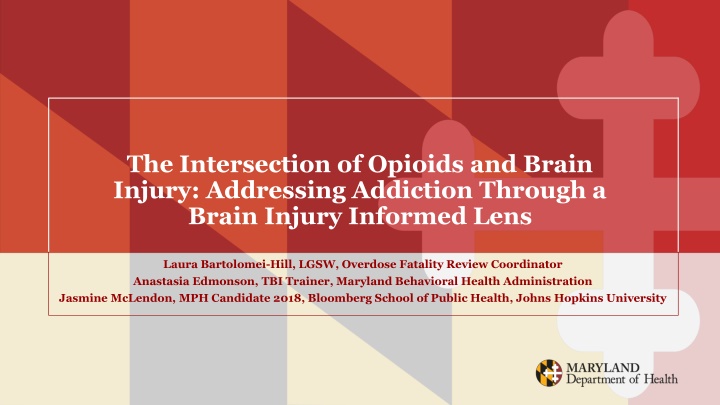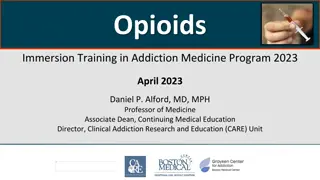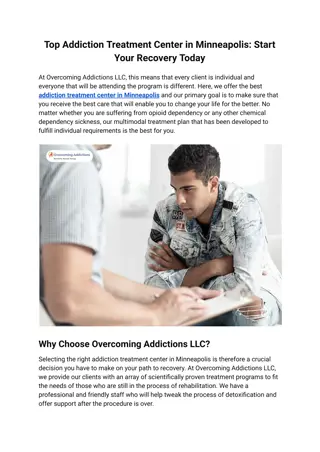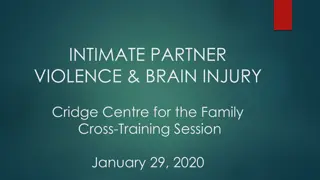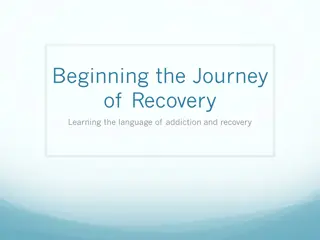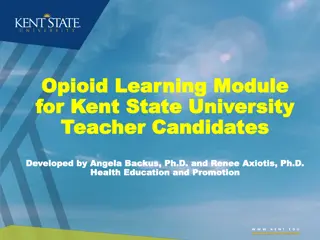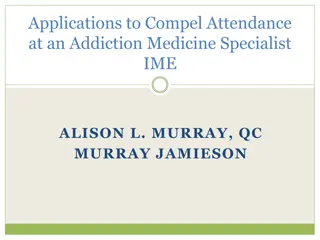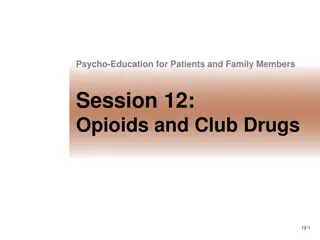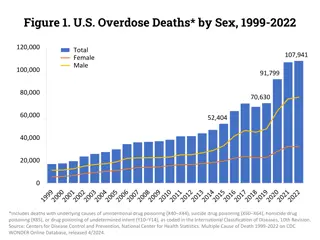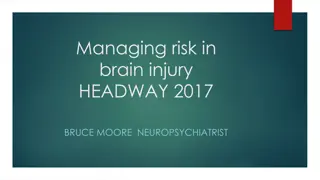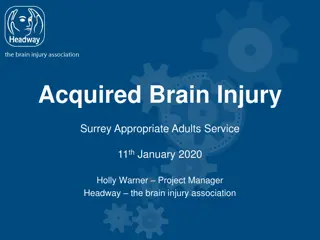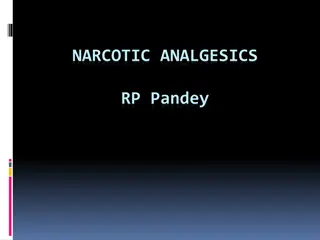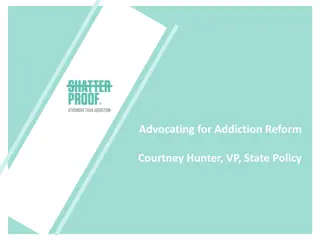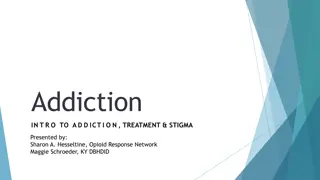The Intersection of Opioids and Brain Injury: Addressing Addiction Through a Brain Injury Informed Lens
Exploring the correlation between traumatic brain injury (TBI) and the opioid crisis, this content delves into the alarming statistics of opioid overdoses and their impact on individuals with brain injuries. Highlighting the overlap and consequences of these two major health issues, it sheds light on the challenges faced in addressing addiction in TBI survivors. With a focus on Maryland's opioid crisis, the content examines the state of emergency declared by Governor Hogan and the rising number of opioid-related deaths. Additionally, it discusses how opioids hijack the brain, leading to devastating consequences such as memory loss and amnesia. Overall, this comprehensive examination advocates for a brain injury-informed approach to tackling addiction and improving outcomes for individuals affected by both issues.
Download Presentation

Please find below an Image/Link to download the presentation.
The content on the website is provided AS IS for your information and personal use only. It may not be sold, licensed, or shared on other websites without obtaining consent from the author.If you encounter any issues during the download, it is possible that the publisher has removed the file from their server.
You are allowed to download the files provided on this website for personal or commercial use, subject to the condition that they are used lawfully. All files are the property of their respective owners.
The content on the website is provided AS IS for your information and personal use only. It may not be sold, licensed, or shared on other websites without obtaining consent from the author.
E N D
Presentation Transcript
The Intersection of Opioids and Brain Injury: Addressing Addiction Through a Brain Injury Informed Lens Laura Bartolomei-Hill, LGSW, Overdose Fatality Review Coordinator Anastasia Edmonson, TBI Trainer, Maryland Behavioral Health Administration Jasmine McLendon, MPH Candidate 2018, Bloomberg School of Public Health, Johns Hopkins University
Traumatic Brain Injury and the Opioid Crisis National Data Traumatic Brain Injury (TBI) Opioid Overdose Overdoses are the leading cause of death for Americans under 50 Overdoses killed more people in 2016 than guns or car accidents, and are doing so at a pace faster than the HIV epidemic at its peak Every day, 115 Americans die from an opioid overdose Disability post overdose survival? In 2013, falls were the leading cause of TBI, accounting for 47 percent of all TBI-related ED visits, hospitalizations, and deaths in the United States. Falls disproportionately affect the youngest and oldest age groups: TBIs contribute to about 30 percent of all injury deaths Every day, 153 people in the United States die from injuries that include TBI Approximately 5.3 million survivors are living with TBI-related disabilities Sources: www.nytimes.com/interactive/2017/08/03/upshot/opioid-drug-overdose-epidemic.html?wpisrc=nl_health202&wpmm=1 www.cdc.gov/traumaticbraininjury/pubs/index.html www.cdc.gov/drugoverdose/epidemic/index.html https://tonic.vice.com/en_us/article/ywzd9k/when-an-overdose-doesnt-kill-you 2
Traumatic Brain Injury and the Opioid Crisis Maryland Overview March 2017: Governor Hogan declares a state of emergency in response to Maryland s opioid crisis 89 percent of all intoxication deaths that occurred in Maryland in 2016 were opioid-related. This figure includes deaths related to heroin, prescription opioids, and nonpharmaceutical fentanyl The number of opioid-related deaths increased by 70 percent between 2015 and 2016 Preliminary data from the first quarter of 2017 indicates that 550 Marylanders died from unintentional intoxication from ingestion/exposure to alcohol and other drugs including heroin, prescription opioids, prescribed and illicit forms of fentanyl, cocaine, benzodiazepines, phencyclidine (PCP), methamphetamines and other prescribed and unprescribed drugs Sources: www.washingtonpost.com/local/md-politics/hogan-declares-opioid-state-of-emergency/2017/03/01/5c22fcfa-fe2f-11e6-99b4-9e613afeb09f_story.html?utm_term=.99d7a98ffc49 https://bha.health.maryland.gov/OVERDOSE_PREVENTION/Documents/Quarterly%20Drug_Alcohol_Intoxication_Report_2017_Q1%20(2).pdf 3
Anatomy of Addiction: How Heroin and Opioids Hijack the Brain Jack Rodolico NPR Jan. 11, 2016 Heroin Contaminated with Fentanyl Dramatically Enhances Brain Hypoxia and Induces Brain Hypotherma Solis et. al in eNeuro Behavioral Neuroscience Branch, National Institute on Drug Abuse NIH Sept./Oct. 2017 Are Opioids Behind a Cluster of Unusual Amnesia Cases? Sarah Zhang The Atlantic Jan. 30, 2017 Memory Loss Hitting Some Fentanyl Abusers Dennis Thompson Healthday Jan. 29, 2018 4
Johnson, 27, lay in a coma, silent except for the beeping of machines. She looked small and pale, buried in a tangle of hospital bedsheets and tubes, after suffering a dozen or so strokes as a result of her latest opioid overdose. Source: https://www.npr.org/2018/04/18/602826966/anguished-families-shoulder-the-biggest-burdens-of-opioid-addiction 5
Traumatic Brain Injury and the Opioid Crisis Observations They all have difficulty learning new information, and its pretty dense. Every day is pretty much a new day for them, and sometimes within a day they can t maintain information they have learned. If their memory is really compromised, it s going to be hard for them to learn a new life that doesn t involve drugs. -Dr. Marc Haut West Virginia University s Department of Behavioral Medicine and Psychiatry Source: https://health.usnews.com/health-care/articles/2018-01-29/memory-loss-hitting-some-fentanyl-abusers 6
Traumatic Brain Injury and the Opioid Crisis Observations One way to think about this would be that anoverdose is like a concussion, where you have a traumatic brain injury to the brain if the person doesn t die, the brain recovers, but they may be, like with a concussion, more susceptible to a future event. And then there also may be cumulative damage that occurs. -Dr. Alex Walley Associated Professor of Medicine, Boston University School of Medicine Source: https://www.npr.org/sections/health-shots/2017/04/13/523452905/what-doesnt-kill-you-can-maim-unexpected-injuries-from-opioids 7
Traumatic Brain Injury and the Opioid Crisis Observations An article in The Atlantic describes a cluster of patients who used opioids and experienced amnesia. Subsequent MRIs conducted on the brains of several of these individuals found Little to no blood was flowing to their hippocampi ... Whatever had damaged the brains of these patients seemed to specifically attack the hippocampus neurons. With their hippocampi impaired, the patients couldn t form new memories. Source: https://www.theatlantic.com/health/archive/2017/01/opioids-amnesia/514697/ 8
Traumatic Brain Injury and the Opioid Crisis Brain Hypoxia Brain cells are very sensitive to a lack of oxygen. Some brain cells start dying less than five minutes after their oxygen supply disappears. As a result, lack of oxygen, or brain hypoxia can rapidly cause severe brain damage or death Brain hypoxia can also occur from near drowning, cardiac arrest, lightening strike, carbon monoxide poisoning, choking secondary to assault/intimate partner violence If the brain is subjected to multiple instances of hypoxia, (as in multiple overdoses) there is cumulative damage to the brain Source: https://medlineplus.gov/ency/article/001435.htm 9
Traumatic Brain Injury and the Opioid Crisis Brain Hypoxia Sudden loss of oxygen to the brain has the greatest effect on parts of the brain that are high oxygen users such as the hippocampus, basal ganglia, and frontal region among others These areas of the brain are oxygen hogs and are critical to memory, learning, and attending to new information; problem solving; and the ability to manage our emotions and impulses In other words, they are responsible for our adult thinking skills Source: Adapted from Ohio Brain Injury Program/John Corrigan PhD 2017 10
Traumatic Brain Injury and the Opioid Crisis Brain Hypoxia The frontal lobe is highly susceptible to brain hypoxia Frontal lobe damage leads to potential loss of executive functions which are often required to participate, engage, and thrive in treatment As a result of frontal lobe damage, survivors of overdose may have issues with noncompliance, poor follow through, or a lack of engagement Decreased ability to participate and engage in substance treatment puts these individuals at increased risk for relapse 11
Traumatic Brain Injury and the Opioid Crisis Brain Hypoxia These consequences are very familiar to those of us in the brain injury community Those who have experienced an external blow or blows to the head with enough force are vulnerable to damage to the frontal lobe, hippocampus, and other parts of the brain In other words, the parts of the brain responsible for our adult thinking skills 12
Traumatic Brain Injury and the Opioid Crisis Behavioral Health Challenges Individuals living with undiagnosed or untreated history of TBI are overrepresented among the homeless, the incarcerated, and those involved with mental health and addiction services Individuals who experience a TBI often, have a prior history of problematic substance use, and individuals without a history of substance abuse are at higher risk of developing addiction post TBI Individuals with a TBI with co-occurring mental health and addiction challenges find it difficult to engage with, and remain in, treatment for these conditions due to the thinking and behavioral barriers common to those with TBI A person with a brain injury is 11 times more likely to die from an accidental poisoning from drugs or alcohol than a person without a history of brain injury 13
Traumatic Brain Injury and the Opioid Crisis Intimate Partner Violence TBI is also represented but underreported in survivors of Intimate Partner Violence (IPV) While evidence exists about the co-occurrence of IPV and TBI, there is only a limited body of research literature on this topic2 IPV victims may experience multiple injuries of violence over the course of multiple incidents as well as in a single violent episode1,2 Most recent studies have found that TBI was found in 30 percent and 74 percent of all IPV victims who sought care in Eds or shelters1,2 Studies also show that, 40 percent of women experiencing IPV had at least one TBI resulting in a loss of consciousness, while 92 percent reported a blow to the head or face 1 Sources: 1. Kwako LE, Glass N, Campbell J, Melvin KC, Barr T, Gill JM. Traumatic Brain Injury in Intimate Partner Violence: A Critical Review of Outcomes and Mechanisms. Trauma, Violence, Abus. 2011;12(3):115-126. doi:10.1177/1524838011404251 Murray CE, Lundgren K, Olson LN, Hunnicutt G. Practice update: What professionals who are not brain injury specialists need to know about intimate partner violence related traumatic brain injury. Trauma, Violence, Abus. 2015;17(3):298-305. doi:10.1177/1524838015584364 14 2.
Traumatic Brain Injury and the Opioid Crisis Overdose Fatality Review Maryland was to apply multidisciplinary case review model to overdose deaths Established as a pilot in three jurisdictions with the support of a Harold Rogers 2013 grant, now operational in 19 of 24 jurisdictions Authorized by law Local OFR (SPELL OUT AT FIRST REFERENCE) teams meet at least quarterly to review cases Teams have met over 250 times and reviewed over 600 cases Teams include representatives from: - - - - - - Department of Social Services Public Education Parole and Probation Detention Center Crisis Services Community Colleges - - - Local Health Departments Law Enforcement Emergency Medical Services Local Hospitals Treatment providers Prevention Office - - - 15
Traumatic Brain Injury and the Opioid Crisis Legislation Goals of OFR H-G 5-903 include: Promote cooperation and coordination among agencies involved in investigations of drug overdose deaths or in providing services to surviving family members Develop an understanding of the causes and incidence of drug overdose deaths in the county Develop plans for and recommend changes within the agencies represented on the local team to prevent drug overdose deaths Advise the Department on changes to law, policy, or practice to prevent drug overdose deaths 16
Traumatic Brain Injury and the Opioid Crisis Public Health Approach Social-ecological model Systems-level perspective Identify gaps and public health programs that address them Non-judgmental approach to individual s story Exploration of new or emerging programs or policies 17
Traumatic Brain Injury and the Opioid Crisis Case Attributes 883 trends observed in 518 cases Mental Health diagnosis or treatment history (135) Previous overdose (92) Somatic Health Condition (78) Pain management (37) Intimate Partner Violence (35) Recent time of abstinence (34) Emerging trends Overdose deaths occurring in a hotel or motel History of traumatic brain injury History of childhood trauma 18
Traumatic Brain Injury and the Opioid Crisis Sample Case Review Decedent: David Hunter, 35, White, Male Resident Jurisdiction: Baltimore City Incident Jurisdiction: Baltimore County Date of Death: Jan. 15, 2018 Cause of Death: Heroin and Fentanyl Intoxication Notes from the Scene: RN at MedStar Harbor Hospital called to report this death. The subject and girlfriend were snorting heroin last night, and this morning she found the subject unresponsive. Family is at ED. No drugs or paraphernalia found on subject, no noted trauma. Per Baltimore City Police, the subject has a long history of heroin and cocaine use. Police have no concerns of foul play. 19
Traumatic Brain Injury and the Opioid Crisis Sample Case Review Prescription Drug Monitoring Program: Rx for 30 oxycodone written by the ED physician 8/6/2016, 8/20/2016, 9/5/2016, 1/13/2017, 12/15/17 Hospital/CRISP: Motor vehicle accident in 2016, subsequent visits for pain Law Enforcement: Assault charges (domestic), theft, and possession. Responded to two previous nonfatal overdoses (2017) Social Services: As a child, subject of a neglect investigation, parental substance use, and domestic violence reported Health Department: Two intakes completed, no follow-up by decedent Detention Center: Short stays only, no long-term detentions Local treatment provider: Discharged for noncompliance and conflict with other patients 20
Traumatic Brain Injury and the Opioid Crisis Sample Case Review What opportunities for intervention can be identified? What barriers existed for this decedent? What recommendations does the team have to prevent future deaths? What underlying issues may be present here? -Which hidden factors may indicate brain injury? - Trauma 21
Traumatic Brain Injury and the Opioid Crisis Family Support 10 (SPELL OUT AT FIRST REFERENCE) OFR teams recommended enhancing support and outreach for family members of overdose decedents and overdose survivors. Assess needs of surviving family members Connect to Substance Use Disorders (SUD) treatment if needed Prioritize family members in Naloxone outreach Make trauma and grief services available to families Engage school-aged children and connect to counseling and services A family member found the decedent in 83 percent of cases -Carroll County 22
Traumatic Brain Injury and the Opioid Crisis Provider Engagement Seven OFR teams recommended engaging health care providers. Promote awareness of the Prescription Drug Monitoring Program Increase the number of prescribers following best practices when prescribing opioids Train providers to screen for SUD and offer recovery-supportive services Increase access to trauma-informed care Four of the 13 FORT cases reviewed had chronic somatic health conditions that require pain management -Anne Arundel County 23
Traumatic Brain Injury and the Opioid Crisis User and Survivor Engagement Seven OFR teams recommended engagement of people who use drugs, including overdose survivors Employ peer-recovery specialists to connect overdose survivors and individuals with a SUD to treatment services via law enforcement and local hospitals Establish syringe service programs Harm reduction education for high-risk individuals Our case reviews show many decedents used intravenous route of administration . . . which shows a need for the service -Howard County 24
Traumatic Brain Injury and the Opioid Crisis Free Training Currently, free training is provided by the Maryland Department of Health, Behavioral Health Administration to Mental Health and Addiction Services professionals in order to: Educate professionals about brain injury and the relationship between traumatic and acquired brain injury and pre as well as post substance use Equip professionals with a validated TBI screening tool Teach professionals how to utilize evidence based strategies and accommodations to help those living with brain injury or suspected brain injury, engage in and maintain engagement in treatment Offer professionals and the individuals they serve and their loved ones brain injury specific resources and programs 25
Traumatic Brain Injury and the Opioid Crisis Substance Abuse and TBI Substance abuse clients with TBI tend to: Have first used at a younger age Have more severe SUD (worse and more prior treatments) Have more co-occurring mental health problems Have poorer prognosis for successful treatment outcomes (more so earlier the age at first TBI?) Source:(Corrigan & Mysiw, 2012) Courtesy of John Corrigan Ph.D. 26
Traumatic Brain Injury and the Opioid Crisis Substance Abuse and TBI Problematic exposure to TBI implies: Person may have difficulty accessing services, or remaining engaged in services, due to barriers created by cognitive and/or behavioral weaknesses. Source:Courtesy of John Corrigan Ph.D. 27
Traumatic Brain Injury and the Opioid Crisis Substance Abuse and TBI Suggestions for providers include: Look for neurologically based cognitive and behavioral barriers to treatment Adapt service provision to accommodate weaknesses Assist with the development of compensatory strategies Be cautious when making inferences about motivation based on observed behaviors Source:Courtesy of John Corrigan Ph.D. 28
Traumatic Brain Injury and the Opioid Crisis Messages to Share Drinking After Brain Injury: Useful for Individuals who are in the Precontemplation or Contemplation Stage of Change Source:*Adapted from Bogner and Lamb-Hart, Ohio Valley Center After a brain injury, alcohol and other drugs have a more powerful effect People who use alcohol or drugs after TBI don t recover as fast as those who don t People who have had a brain injury are more likely to have times when they feel sad or depressed and drinking or doing drugs can make these problems worse Any injury-related problems in balance, walking, or talking can be made worse by using drugs or alcohol People who have had a brain injury often say or do things without thinking first, a problem made worse by using alcohol or drugs After a brain injury, drinking alcohol or taking drugs can increase the risk of seizure People who drink alcohol or use other drugs after a brain injury are more likely to have another brain injury Brain injuries cause problems with thinking, like concentration or memory, and alcohol makes these worse 29
Traumatic Brain Injury and the Opioid Crisis Messages to Share 12 Steps of Alcoholics Anonymous (AA) for TBI Source:Developed by William Peterman, BS, CADAD and reprinted with permission of the National Head Injury Foundation Substance Abuse Task Force White Paper, Southborough, MA: NHIF, 1988. Admit that if you drink and/or use drugs your life will be out of control. Admit that the use of substances after having a traumatic brain injury will make your life unmanageable Ask God for the strength to be a responsible person with responsible behaviors Make a list of people your negative behaviors have affected. Be ready to apologize or make things right with them You start to believe that someone can help you put your life in order. This someone could be God and AA/AN group, counselor, sponsors, etc. Contact these people. Apologize or make things right Continue to check yourself and your behaviors daily. Correct negative behaviors and improve them. If you hurt another person, apologize and make corrections You decide to get help from others or God. You open yourself up You will make a complete list of the negative behaviors in your past and current behavior problems. You will also make a list of your positive behaviors Stop and think how you are behaving several times a day. Are my behaviors positive? Am I being responsible? If not, ask for help. Reward yourself when you are able to behave in a positive and responsible fashion Meet with someone you trust and discuss what you wrote above Become ready to sincerely try to change your negative behaviors If you try to work these Steps, you will start to feel much better about yourself. Now it's your turn to help others do the same. Helping others will make you feel even better. Continue to work these Steps on a daily basis 30
Traumatic Brain Injury and the Opioid Crisis Brain Injury Screening Screening for history of Brain Injury and providing individualized accommodations and strategies for brain injury-related barriers are an essential foundation of a person-centered treatment plan Outcomes Services Objectives-supported by interventions Strengths/Barriers- HOLISTIC Goals-Of the Individual Source: Adapted from Grieder & Adams, 2005 Prioritization- VIEWED THROUGH TBI Related Awareness/Needs Understanding-HOW HX informs behavior Assessment-SCREEN for HX of TBI Request for services 31
Traumatic Brain Injury and the Opioid Crisis Brain Injury Screening http://ohiovalley.org/tbi-id-method/ 32
Traumatic Brain Injury and the Opioid Crisis Accommodating Symptoms Accommodating the symptoms of Brain Injury: See handout: http://ohiovalley.org/informationeducation/accommodatingtbi/accommodationspresentation/ 33
Traumatic Brain Injury and the Opioid Crisis Accommodating Symptoms PAGE 10- Reflective Recommendations Learning new material Remembering assignments Staying on track Figuring out how to do new things What helps you with . . . ? Making choices that keep you healthy and safe 34
Traumatic Brain Injury and the Opioid Crisis To Enhance Memory Structure the environment: Encourage repetition of information to promote procedural memory Write information down Review, Rehearse, Repeat Use of compensatory strategies such as: Use of a calendar, alarms, smart devices Creation of a daily schedule, "To do lists, and shopping lists Labeling items 35
Traumatic Brain Injury and the Opioid Crisis Strategies Use a journal/calendar Create a daily schedule Learning to break tasks into small manageable steps Use of a digital recorder/smart phone app Work on accepting coaching from others Work on generalizing strategies to new situations Use of a high lighter (RED) Alarms (on phone, watch, etc.) to move through the day Partitions/cubicles at work and quiet space at home Model tasks e.g. turning on a computer and accessing email, etc. Use of pictures for faces/names, basic information for step-by-step procedures, e.g. making coffee Encourage use of rest and low activity periods, naps are to be encouraged Use of a template for routine tasks, on the job, at home, in the community Use of ear plugs to increase attention, screen out distractions (Parente & Herman 1996) 36
Traumatic Brain Injury and the Opioid Crisis More Strategies Use of a timer to track breaks at work, the time minimum technique, allocated time to puzzle over a problem or vent a frustration Audio books, movies, keep the subtitles (for processing content in the case of memory and comprehension problems and increase awareness of nonverbal cues/communication) 37
Traumatic Brain Injury and the Opioid Crisis Recommendations Individuals in seeking treatment and in recovery from opioid addiction should be screened for a history of a prior TBI Addiction services professionals, individuals in treatment and recovery, as well as their families and supporters should be aware of the possible thinking and memory problems that may result from exposure to opioids Difficulty engaging in treatment should not automatically be interpreted as resistance, rather lack of treatment engagement and compliance maybe directly the result of opioid involved brain damage and may benefit from best practices currently recommended for individuals in recovery from brain injury with or without a history of SUD 38
Traumatic Brain Injury and the Opioid Crisis Recommendations Visit https://bha.health.maryland.gov/Pages/mdtbiadvisoryboard.aspx to read the current Maryland Traumatic Brain Injury Advisory Board report and recommendations for enhancing and expanding services for Marylanders and their families affected by TBI Expand Brain Injury Services to accommodate the increase in those affected by brain injury secondary to opioid overdose(s) Message to all stakeholders: Addressing the major public health issues of Brain Injury and the opioid epidemic requires a compressive and broad multi-pronged approach that includes Naloxone training and availability, as well as prevention, education, and rehabilitation strategies. Maryland is poised to be a national leader in addressing the connection between substance use related disorders and brain injury. 39
Traumatic Brain Injury and the Opioid Crisis PHASE Internship Public Health Applications for Student Experiences (PHASE) is a graduate internship program co-sponsored by the Maryland Department of Health and the Johns Hopkins Bloomberg School of Public Health (JHSPH) Offers JHSPH students the opportunity to get real world public health practice experience The goal of this internship project was to explore and identify the connections of brain injury, substance use, and overdose risk injuries and the ways in which (1) these injuries inform treatment adherence and (2) how providers and service agencies can best accommodate these individuals 40
Traumatic Brain Injury and the Opioid Crisis PHASE Internship Traumatic Brain Injury and Opioid Overdose Fact Sheet Living With A Traumatic Brain Injury Quick Facts Quick Facts T raumatic Brain Injury (TBI) is one of the leading causes of death and permanent disability in the United States. It can be caused by a bump, blow, or jolt to the head that disrupts the normal function of the brain 1 What is a TBI? 2 2..8 8 M MI IL LL LI IO ON N In 2013 in the U.S., 2.8 million TBI-related emergency department (ED) visits, hospitalizations, and deaths occurred.1 A traumatic brain injury (TBI) is an insult to the brain caused by a bump, blow, or jolt to the head that disrupts the normal function of the brain. 1 Linking TBI to Overdose Between 2012 and 2015, the number of TBI-related deaths in Maryland ranged between 649 to 706 per year.2 TBI-related emergency department visits, hospitalizations, and deaths occurred in the U.S. in 2013 TBI s are overrepresented in homeless, incarcerated, armed forces, athletes, mental health services, and addiction services populations What Changes? In 2015 in the U.S., over 32,000 deaths were due to opioid related drug overdoses.3 A common symptom of opioid overdose is loss of consciousness Loss of consciousness puts a person at increased risk of head injury, such as from a fall, and may cause a TBI Thinking Physical Emotional From January through October 2017, 1,705 overdose deaths occurred in Maryland. 4 1 1..5 5x x MORE LIKELY TO HAVE A MENTAL HEALTH PROBLEM Poor impulse control Poor coping skills Poor insight Decreased learning Memory Difficulties Attention Deficits Irritability Temper Outbursts Unawareness Confabulation ( making up stories ) Mood swings Overdoses can deprive the brain of oxygen and lead to injury Poor Coordination Slowed or slurred speech Visual Deficits Fatigue Decreased hearing The frontal lobe is highly susceptible to brain oxygen loss Frontal Lobe Functions Frontal lobe damage leads to potential loss of executive functions which are often required to participate, engage, and thrive in treatment Increased risk of depression Frontal lobe damage leads to decreased learning and problem solving, poor impulse control, and reduced ability to cope Planning Organizing Emotional and behavioral control Personality Problem solving Attention Social Skills Flexible Thinking Memory for habits Vestibulum congue tempus As a result of frontal lobe damage, survivors of overdose may have issues with noncompliance, poor follow through or a lack of engagement Increased risk of anxiety How Can I Help? Lorem ipsum dolor sit amet, consectetur adipiscing elit, sed do eiusmod tempor. Decreased ability to participate and engage in substance treatment puts these individuals at increased risk for relapse Increased risk of psychosis Create a daily schedule; routinize the day as much as possible Increased risk of suicide Be Consistent - put things in the same place, wallet, keys, phone, etc. The number of patients that have brain changes as a result of substance abuse is significantly overlooked in most treatment facilities -Dr. Frank R. Sparadeo Partition off quiet space at home What About Me? Model tasks- turning on a computer, accessing email, etc. Your role in the family may change So What Do We Do Now? Use pictures for faces/names, basic information for step-by-step procedures, such as making coffee Encourage use of rest and low activity periods Taking care of your loved one may become stressful It s important for treatment professionals to clue in to whether a client s behavior is due to an underlying neurological impairment or if it has a psychological basis. Break tasks into small, manageable steps Incorporate frontal lobe functional barriers into treatment planning: Small group settings Present information in multiple formats (Verbal, Visual, Auditory) Present information in small chunks Use of role-playing Allow for increased time to process information Repeat presentations of key information Take time to take care of yourself Accessibility- things that are commonly used, keep them physically close, (kitchen, office, etc.) Seek out support groups Use of ear plugs to increase attention and screen out distractions Sources 1. 2. 3. https://www.cdc.gov/traumaticbraininjury/get_the_facts.htm Edmonston, A (2017). Traumatic Brain Injury: An Overview for Behavioral Providers [Powerpoint Slides] Center, M. S. K. T. (2017). Resources Offered by the MSKTC To Support Individuals Living With Traumatic Brain Injury. Model Systems Knowledge Translation Center. Washington D.D. Retrieved from http://www.msktc.org/tbi Parente and Herrman( 1996). Retraining Cognition, Techniques, and Applications Sources 4. 5. 6. https://bha.health.maryland.gov/OVERDOSE_PREVENTION/Pages/Data-and-Reports.aspx. Edmonston, A (2017). Traumatic Brain Injury- Tools for Behavioral Health Professionals [Powerpoint Slides] Corrigan, J. (2018, March 2). Phone Interview 1. 2. 3. https://www.cdc.gov/traumaticbraininjury/get_the_facts.htm Maryland Traumatic Brain Injury Advisory Board. 2017 Annual Report https://www.cdc.gov/mmwr/volumes/65/wr/mm655051e1.htm 4. 41
Traumatic Brain Injury and the Opioid Crisis Resources The Brain Association of Maryland www.biamd.org 410-448-2924 42
Traumatic Brain Injury and the Opioid Crisis Resources Ohio Valley Center for Brain Injury Prevention and Rehabilitation: 614-293-3802 www.ohiovalley.org provides information and resources regarding addiction, mental health and brain injury as well as a tutorial on how to use the Ohio State University Traumatic Brain Injury Identification screening tool Brainline: www.brainline.org funded through the Defense and Veterans Brain Injury Center offers civilians, returning service members with brain injury, families, and professionals a variety of information and resources regarding life after brain injury 43
Traumatic Brain Injury and the Opioid Crisis Maryland Resources Where to find treatment in your community via the Maryland Certified Treatment Locator and the Substance Abuse and Mental Health Services Administration s (SAMHSA) Treatment Locator The Maryland Crisis Hotline: 211 (press 1) What is medication assisted treatment and how to access it 44
Traumatic Brain Injury and the Opioid Crisis Contacts Behavioral Health Administration s Traumatic Brain Injury Information and Services: https://bha.health.maryland.gov/Pages/Traumatic-Brain-Injury.aspx Maryland Traumatic Brain Injury Advisory Board: https://bha.health.maryland.gov/Pages/Traumatic- Brain-Injury.aspx Anastasia Edmonston: anastasia.edmonston@maryland.gov; 410-402-8478 Laura Bartolomei-Hill: laura.bartolomei-hill@maryland.gov; 410-402-8491 Jasmine McClendon: jmcclen2@jhu.edu 45
